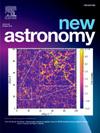DRsm: Star spectral classification algorithm based on multi-feature extraction
IF 2.1
4区 物理与天体物理
Q2 ASTRONOMY & ASTROPHYSICS
引用次数: 0
Abstract
With the development of information technology, data-driven astronomical research has become a very popular subject. In view of the huge amount of spectral data from the sky, it is necessary to find suitable automatic processing methods to meet the needs of the time. Based on DenseNet model and ResNet model, DRsm (DenseNet ResNet SoftMax) algorithm is built in this paper, which realizes the automatic classification of stellar spectra. There are 6 steps to the DRsm algorithm: (1) Normalization processing: The Min–max normalization function is used to normalize the stellar spectrum to speed up the algorithm. (2) Denoising processing: The Ces algorithm is employed to denoise the stellar spectrum by reducing the photon noise that affects the spectral observations. (3) Composite RGB image: Three channels of an RGB image, corresponding to the gray image generated by the same spectrum. By superimposing the same spectrum, the effective distinguishing features of the stellar spectrum become more apparent and subsequent work is made easier. Here, we have normalized the continuous spectrum of the stellar spectrum, so that the content shown in the RGB image is basically the spectral line information of the star spectrum. At the same time, we analyze the feasibility of data conversion (synthetic RGB image) : using the main spectral line information of the star spectrum as a reference, we investigate whether the relevant pixel position of the synthesized RGB image contains these features. (4) Data enhancement: The Bottom-hat transformation (Top-hat transformation, contrast enhancement algorithm) is used to enhance the converted data, so that the main distinguishing features of the star spectrum are more obvious. (5) Feature extraction: The ResNet model and DenseNet models are used to extract features from stellar spectra, and the RGB image with a scale of 64 × 64 is extracted as a one-dimensional feature vector. (6) Automatic classification: The feature vector is then sent to the SoftMax module where it is automatically classified. The loss function used by the SoftMax module is ‘data set loss + regular term loss’. When the DRsm algorithm is used to automatically classify the spectra of A, B, dM, F, G, gM and K-type stars with R-band signal-to-noise ratio greater than 30, the classification accuracy is 0.96. The classification accuracy of this method is notably higher than that of the CNN(Convolutional Neural Networks)+Bayes, CNN+KNN, CNN+SVM, CNN+AdaBoost, and CNN+RF algorithms, which achieved accuracies of 0.862, 0.876, 0.894, 0.868, and 0.889, respectively.
DRsm:基于多特征提取的光谱分类算法
随着信息技术的发展,数据驱动的天文研究已经成为一个非常热门的课题。鉴于来自天空的光谱数据量巨大,有必要寻找合适的自动处理方法来满足时间的需求。本文在DenseNet模型和ResNet模型的基础上,构建了DRsm (DenseNet ResNet SoftMax)算法,实现了恒星光谱的自动分类。DRsm算法分为6个步骤:(1)归一化处理:利用Min-max归一化函数对恒星光谱进行归一化处理,加快算法速度。(2)降噪处理:采用Ces算法对恒星光谱进行降噪处理,降低影响光谱观测的光子噪声。(3)复合RGB图像:一幅RGB图像的三个通道,对应同一光谱生成的灰度图像。通过重叠相同的光谱,恒星光谱的有效区分特征变得更加明显,从而使后续工作更加容易。在这里,我们对恒星光谱的连续光谱进行了归一化处理,使得RGB图像中显示的内容基本上就是恒星光谱的光谱线信息。同时,我们分析了数据转换(合成RGB图像)的可行性:以恒星光谱的主谱线信息为参考,研究合成RGB图像的相关像素位置是否包含这些特征。(4)数据增强:采用Bottom-hat变换(Top-hat变换,对比度增强算法)对转换后的数据进行增强,使恒星光谱的主要区分特征更加明显。(5)特征提取:利用ResNet模型和DenseNet模型对恒星光谱进行特征提取,提取尺度为64 × 64的RGB图像作为一维特征向量。(6)自动分类:将特征向量发送给SoftMax模块进行自动分类。SoftMax模块使用的损失函数是“数据集损失+常规项损失”。采用DRsm算法对r波段信噪比大于30的A、B、dM、F、G、gM和k型恒星的光谱进行自动分类时,分类精度为0.96。该方法的分类准确率明显高于CNN(Convolutional Neural Networks)+Bayes、CNN+KNN、CNN+SVM、CNN+AdaBoost、CNN+RF算法,准确率分别为0.862、0.876、0.894、0.868、0.889。
本文章由计算机程序翻译,如有差异,请以英文原文为准。
求助全文
约1分钟内获得全文
求助全文
来源期刊

New Astronomy
地学天文-天文与天体物理
CiteScore
4.00
自引率
10.00%
发文量
109
审稿时长
13.6 weeks
期刊介绍:
New Astronomy publishes articles in all fields of astronomy and astrophysics, with a particular focus on computational astronomy: mathematical and astronomy techniques and methodology, simulations, modelling and numerical results and computational techniques in instrumentation.
New Astronomy includes full length research articles and review articles. The journal covers solar, stellar, galactic and extragalactic astronomy and astrophysics. It reports on original research in all wavelength bands, ranging from radio to gamma-ray.
 求助内容:
求助内容: 应助结果提醒方式:
应助结果提醒方式:


